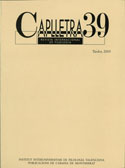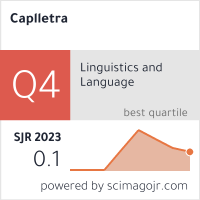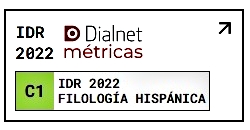Entre la dixi i la definitud: els verbs de moviment resultatiu en català
DOI:
https://doi.org/10.7203/caplletra.39.4852Keywords:
semasiology, verb «venir», medieval catalan language Abstract
Abstract
This article intends to present a brief study on the semasiologic extension of the Catalan verb «venir» —«to come»— in the old and mediaeval language, in contrast to the verb «anar» —to go. It is maintained here that the verb to come in the old language had a more extense meaning than in the current language, fundamentally in relation to the contexts of movement towards a place not occupied by any of the interlocutors of the speech. To elaborate this analysis we start from a corpus of thirty-five texts, which includes four centuries, from the first-known texts written in Catalan (at the end of the twelfth century, beginning of the eleventh century) to the sixteenth century.
 Downloads
Downloads
Downloads
Published
How to Cite
-
Abstract480
-
PDF (Català/Valencià)325
Issue
Section
License
Authors submitting work to Caplletra for publication must be the legitimate holder of the usage rights. Legitimacy for the purposes of publishing the work must also include images, tables, diagrams and any other materials that may complement the text, whether they are the author of such material or not.
Copyright: on publishing their work in the journal, the author grants Caplletra. Revista Internacional de Filologia usage rights (reproduction, distribution and public communication) for both the paper printed version and for the electronic version.
All work published in Caplletra is covered by the Creative Commons license type Attribution-NonCommercial-NoDerivatives 4.0 (CC BY-NC-ND 4.0).
RESPONSABILITY
Caplletra. Revista Internacional de Filologia does not necessarily identify with the points of view expressed in the papers it publishes.
Caplletra. Revista Internacional de Filologia accepts no responsibility whatsoever for any eventual infringement of intellectual property rights on the part of authors.







